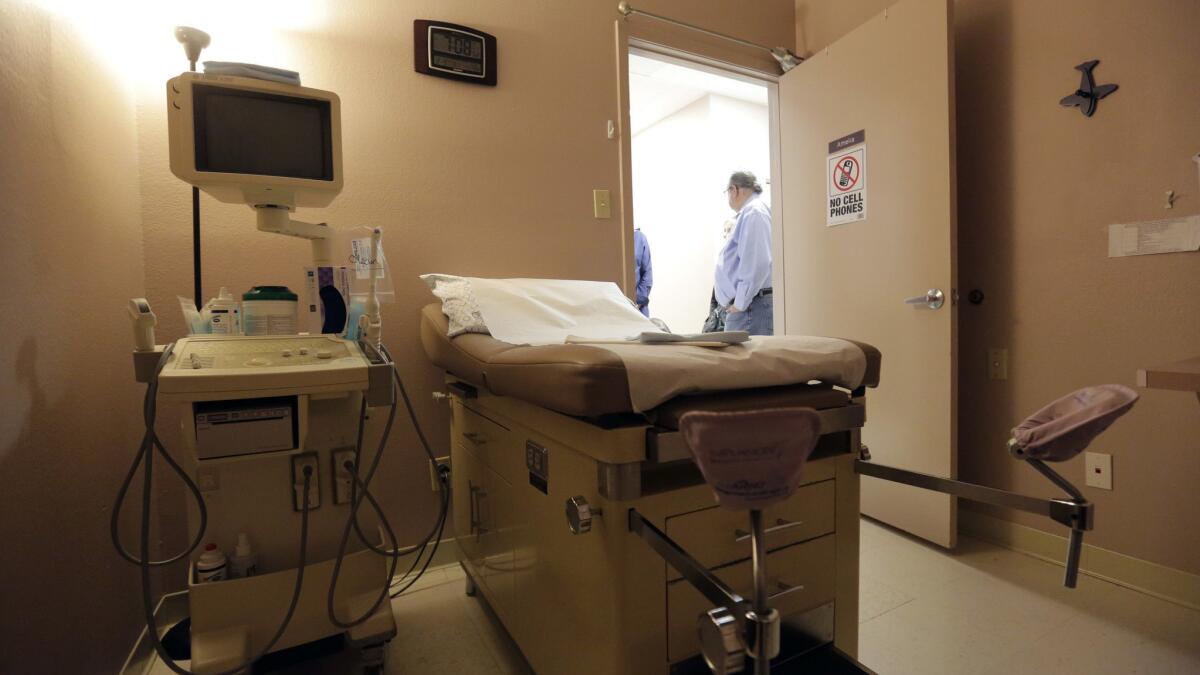Editorial: A Texas abortion procedure ban is unnecessary, full of theatrics and harmful to women

- Share via
No matter how often a woman’s constitutional right to an abortion is upheld by federal courts, there’s a state legislature somewhere trying to make it impossible for her to have one. The assaults on abortion rights have come in waves, as state legislatures dominated by anti-abortion lawmakers simultaneously pursue the same new legal gambits until blocked by a federal judge, at which point they change tactics and try again.
Most recently, abortion opponents have shifted from seeking restrictions ostensibly designed to protect the health of a pregnant woman — such as requiring abortion clinics to be outfitted like outpatient surgery centers, or requiring doctors who perform abortions to have admitting privileges at a nearby hospital — to ones that focus on the fetus. For example, Texas and a number of other states slapped tough new restrictions on the dilation and evacuation procedure, or D&E, the safest and most common second-trimester abortion, calling it a “dismemberment abortion” and describing the procedure in ghoulish detail.
Opponents of the Texas law sued, and U.S. District Court Judge Lee Yeakel rightly saw through the theatrics of the law and permanently enjoined it. Yeakel held that the measure put an undue burden on a woman exercising her right to an abortion in the second trimester. The state of Texas has appealed that decision; the 5th Circuit Court of Appeals judges who recently heard the case should also see it for what it is and uphold Yeakel’s ruling.
The Texas state Legislature has been relentless in its efforts to stop women from exercising their legal right to an abortion.
According to Texas Atty. Gen. Ken Paxton, the law is a response to the “brutality” of the D&E procedure. Yet there’s no legitimate medical evidence that anything brutal is going on here. All mainstream medical experts have concluded that the fetus at that stage does not have the neurological capability to feel pain. (Even the law doesn’t argue that it does.) The real intention of this law is to shock the public with its description of how the remains of an aborted fetus are removed from a woman’s body, and thus weaken support for abortion rights.
Granted, the law — part of a package of unnecessary restrictions on abortion enacted in 2017 — does allows doctors to perform a D&E if they first stop the fetal heart by injecting the fetus with a lethal drug in utero or cutting the umbilical cord. But that’s not as simple as it may sound, and it needlessly imperils the mother.
The doctor could inject digoxin or potassium chloride through a woman’s abdomen into the fetus. But the injections can be technically difficult, painful, risky and, in the case of digoxin, must be administered a day before the abortion — meaning an extra trip to the doctor. Potassium chloride is also dangerous to a woman if it is inadvertently injected into her circulatory system. And umbilical cord transection, which involves passing instruments through the cervix to cut the slender cord, risks causing blood loss and infection in the woman, as well as injury to her uterus.
Enter the Fray: First takes on the news of the minute from L.A. Times Opinion »
These procedures would require abortion providers to undergo so much additional training that some have said they would simply stop performing second-trimester abortions altogether. Yeakel found these added steps to be the very definition of substantial obstacles to a woman’s right to an abortion. The judge also noted that a previous U.S. Supreme Court decision upholding a federal ban on the so-called partial-birth abortion specifically pointed to the D&E procedure as an acceptable alternative.
Texas is one of nine states with nearly identical prohibitions on D&Es. In the seven states where the laws have been challenged in court, all have been blocked, either permanently or until the case is tried. In Alabama, the state government appealed its permanent injunction and lost in the appellate court. The state is expected to ask the Supreme Court to take up the issue.
The Texas state Legislature has been relentless in its efforts to stop women from exercising their legal right to an abortion. When the Supreme Court tossed out the state’s onerous requirements for abortion clinics and providers in 2016, the statehouse just kept churning out other restrictions, both absurd (such as the requirement that fetal remains be buried or cremated, which has also been struck down) and serious. The 5th Circuit should see a restriction on this common and safe second-trimester procedure as onerous and unlawful, and uphold the injunction.
Follow the Opinion section on Twitter @latimesopinion or Facebook
More to Read
A cure for the common opinion
Get thought-provoking perspectives with our weekly newsletter.
You may occasionally receive promotional content from the Los Angeles Times.










